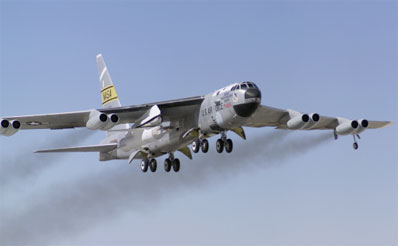
Spaceflight Now +

|

|

|

|

Premium video content for our Spaceflight Now Plus subscribers.

X-43A test
 NASA's X-43A research craft and its Pegasus rocket booster complete a captive carry test flight aboard a B-52 launch aircraft. (1min 48sec file) NASA's X-43A research craft and its Pegasus rocket booster complete a captive carry test flight aboard a B-52 launch aircraft. (1min 48sec file)
 Play video Play video

See the KSC damage
 See damage to the Vehicle Assembly Building, the Saturn 5 Center and other facilities at Kennedy Space Center caused by Hurricane Jeanne. (4min 31sec file) See damage to the Vehicle Assembly Building, the Saturn 5 Center and other facilities at Kennedy Space Center caused by Hurricane Jeanne. (4min 31sec file)
 Play video Play video

Cape damage report
 Jim Kennedy, director of the Kennedy Space Center, and Col. Mark Owen, 45th Space Wing commander, hold a news conference on Monday, Sept. 27 to provide a preliminary report on damage from Hurricane Jeanne at KSC and Cape Canaveral Air Force Station. (49min 30sec file) Jim Kennedy, director of the Kennedy Space Center, and Col. Mark Owen, 45th Space Wing commander, hold a news conference on Monday, Sept. 27 to provide a preliminary report on damage from Hurricane Jeanne at KSC and Cape Canaveral Air Force Station. (49min 30sec file)
 Play audio Play audio

Hurricane Jeanne
 Cameras aboard the International Space Station captured these views of Hurricane Jeanne on Saturday, Sept. 25 as the storm approached Florida. (3min 59sec file) Cameras aboard the International Space Station captured these views of Hurricane Jeanne on Saturday, Sept. 25 as the storm approached Florida. (3min 59sec file)
 Play video Play video

Station news briefing
 International Space Station program manager Bill Gerstenmaier holds a news conference Sept. 24 to discuss problems with the oxygen generation system and Expedition 10 launch preparations. (44min 06sec file) International Space Station program manager Bill Gerstenmaier holds a news conference Sept. 24 to discuss problems with the oxygen generation system and Expedition 10 launch preparations. (44min 06sec file)
 Play audio Play audio

Galaxy clusters collide
 Scientists describe a cosmic hurricane in this news conference from Sept. 23, explaining how two merging galaxy clusters churn high-pressure shock waves that leave thousands of galaxies strewn in the wake. (53min 24sec file) Scientists describe a cosmic hurricane in this news conference from Sept. 23, explaining how two merging galaxy clusters churn high-pressure shock waves that leave thousands of galaxies strewn in the wake. (53min 24sec file)
 Play audio Play audio

 Become a subscriber Become a subscriber
 More video More video

|

|

|

|

|

|

X-43A captive carry rehearsal flight successful
NASA-DFRC NEWS RELEASE
Posted: September 28, 2004
NASA aeronautics researchers are looking forward to flying the X-43A research aircraft at speeds up to 10 times the speed of sound later this fall, following a successful "captive carry" dress rehearsal flight from NASA's Dryden Flight Research Center Sept. 27.

Credit: NASA-DFRC
|
According to X-43A lead operations engineer David McAllister, who served as test director for the mission, the captive carry flight duplicated all operational functions of the planned 7,000-mph - or Mach 10 - flight and served as a training exercise for staff, except that the X-43A and its modified Pegasus booster were not released from NASA's B-52B launch aircraft and their engines were not ignited.
"We have two primary purposes for doing a captive carry flight," said McAllister. "The first is to make sure that the X-43 and its booster rocket - two highly complex systems - are ready for flight. The second is to make sure we're well trained. It's a very big operation (and) we want to make sure that all those people and all those systems are ready to go."
The X-43A is powered by a revolutionary air-breathing supersonic-combustion ramjet - or "scramjet" - engine. Scramjet engines could enable future hypersonic aircraft or space-access vehicles to either carry a greater payload or be smaller and lighter, since they would not have to carry large oxidizer tanks as present-day launch rockets do. If successful, the Mach 10 flight will break all speed records for an aircraft powered by an air-breathing engine.
After a review of captive-carry flight data, project engineers are expected to set a tentative date for the final X-43A flight for early November.
The X-43A project is part of the Hyper-X hypersonic research program led by NASA's Aeronautics Research Mission Directorate and operated jointly by NASA's Langley Research Center, Hampton, Va., and Dryden Flight Research Center, Edwards, Calif. The program aims to demonstrate air-breathing engine technologies that promise to increase payload capacity - or reduce vehicle size for the same payload - for future hypersonic aircraft and reusable space launch vehicles.

Additional coverage for subscribers:
 VIDEO:
X-43A CAPTIVE CARRY FLIGHT TEST ON B-52 QT VIDEO:
X-43A CAPTIVE CARRY FLIGHT TEST ON B-52 QT
 SUBSCRIBE NOW SUBSCRIBE NOW

|

|

|

|
|



